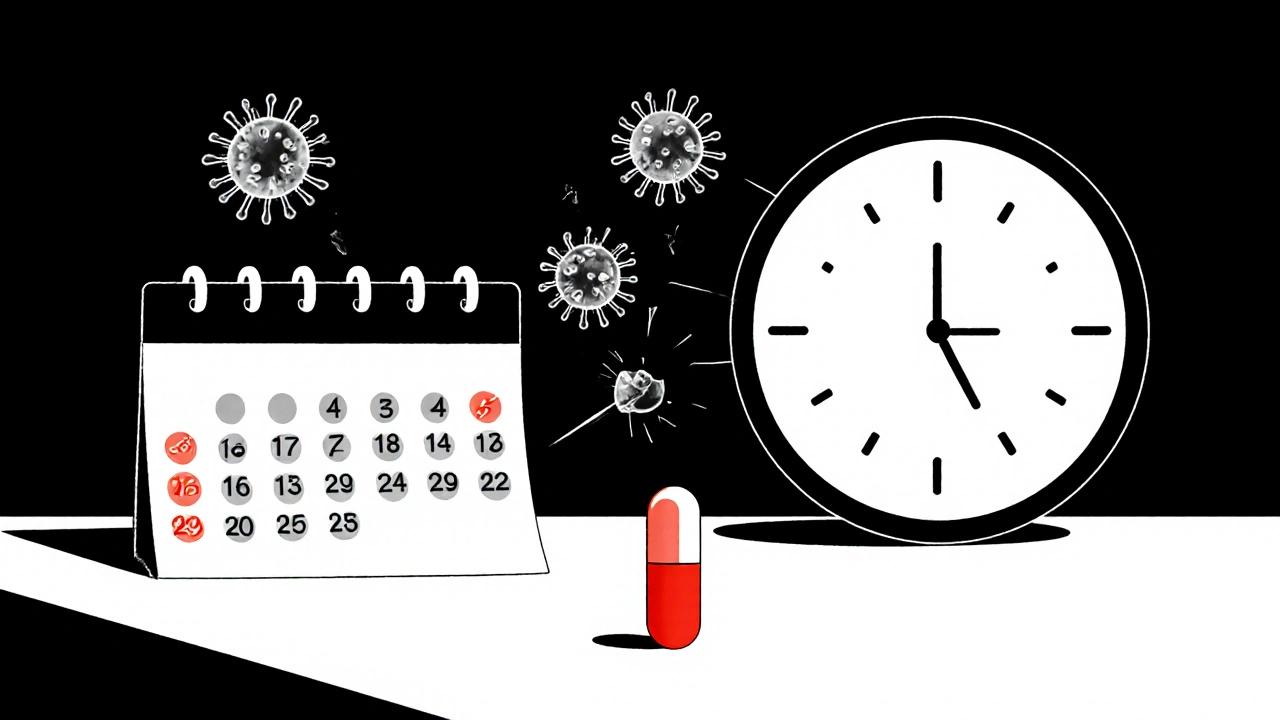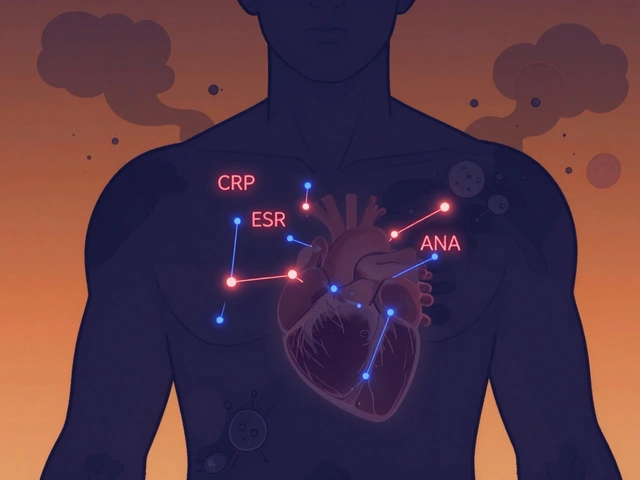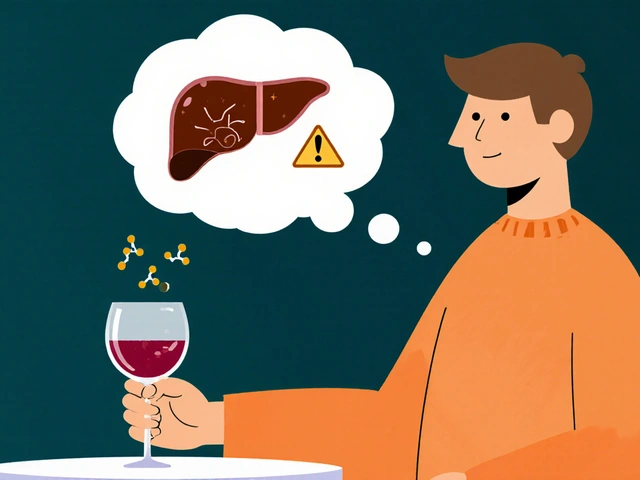
Atazanavir doesn’t just fight HIV-it outsmarts it. Every time the virus tries to copy itself inside your body, atazanavir steps in and shuts down the process before it can finish. This isn’t guesswork. It’s precision chemistry, honed over decades of research, designed to block one critical step in HIV’s life cycle: protein cutting.
What Atazanavir Actually Does
Atazanavir is a protease inhibitor, a type of antiretroviral drug used to treat HIV infection. It doesn’t kill the virus. It doesn’t boost your immune system. It doesn’t prevent HIV from entering cells. What it does is simpler and more elegant: it stops HIV from assembling new, infectious copies of itself.
Here’s how it works. HIV is made of proteins stitched together like a puzzle. One of those proteins, called the HIV protease enzyme, acts like molecular scissors. After the virus hijacks a human cell, it produces long chains of proteins that need to be cut into smaller, functional pieces. Without those cuts, the virus can’t build its outer shell or pack its genetic material. The result? Non-infectious, broken particles that can’t spread.
Atazanavir slips into the active site of the HIV protease enzyme-the exact spot where the scissors should cut. It fits perfectly, like a key jammed into a lock. Once it’s there, the enzyme can’t do its job. The protein chains stay long and useless. New virus particles form, but they’re empty shells. They can’t infect other cells. The infection stalls.
Why This Matters in Real Life
In clinical trials, when atazanavir was added to a standard HIV treatment regimen, over 80% of patients achieved undetectable viral loads within 48 weeks. That’s not a small number-it’s life-changing. Undetectable means untransmittable. People on effective treatment can live long, healthy lives and won’t pass HIV to partners.
But not all protease inhibitors are the same. Atazanavir has a few unique traits. Unlike older drugs in its class, it doesn’t need to be taken with fatty meals to be absorbed. It’s also less likely to raise cholesterol or triglycerides, which reduces long-term heart risks. For many patients, that makes it easier to stick with over years.
It’s also dosed once daily. That’s a big deal. Taking pills at the same time every day, without fail, is the single most important factor in keeping HIV under control. Miss a dose, and the virus can start mutating. Miss several, and resistance can develop. A simple once-daily pill increases adherence-and saves lives.

How It Compares to Other HIV Drugs
Atazanavir isn’t the only protease inhibitor on the market. Others include lopinavir, darunavir, and ritonavir. But each has trade-offs.
| Drug | Dosing | Food Requirement | Common Side Effects | Drug Interactions |
|---|---|---|---|---|
| Atazanavir | Once daily | Not required | Jaundice, nausea, headache | High-avoid certain statins, antacids |
| Darunavir | Once daily (with booster) | With food | Diarrhea, rash, liver enzyme changes | Very high-many restrictions |
| Lopinavir/ritonavir | Twice daily | With food | GI upset, high cholesterol, insulin resistance | Extremely high |
| Ritonavir (booster only) | Once or twice daily | With food | Nausea, taste changes, liver stress | Extremely high |
Atazanavir stands out because of its tolerability profile. One of its most noticeable side effects is mild jaundice-a yellowing of the skin or eyes. It’s not liver damage. It’s caused by a harmless buildup of bilirubin, a natural byproduct of red blood cell breakdown. The drug slightly blocks a liver enzyme that normally clears bilirubin. It’s harmless, but it can scare patients. Doctors need to explain this upfront so people don’t panic and stop taking it.
Who Benefits Most From Atazanavir?
Atazanavir works best for people who are starting HIV treatment for the first time and don’t have drug-resistant strains. It’s often paired with two nucleoside reverse transcriptase inhibitors (NRTIs)-like tenofovir and emtricitabine-to form a complete regimen.
It’s not ideal for everyone. People with severe liver disease, or those taking certain heart medications like amiodarone or ergot derivatives, should avoid it. It can also interfere with acid-reducing drugs like omeprazole or antacids. If you take those, you need to space them out by at least 2 hours before or after atazanavir.
For pregnant women, it’s one of the few protease inhibitors considered safe during pregnancy. Studies show it crosses the placenta effectively, helping reduce mother-to-child transmission. That’s why it’s included in WHO guidelines for HIV treatment in pregnancy.

Resistance: The Constant Threat
No drug works forever if it’s not taken correctly. HIV mutates fast. If someone misses doses regularly, the virus can develop mutations that change the shape of the protease enzyme. Suddenly, atazanavir no longer fits snugly in the lock. The scissors start working again.
Common resistance mutations linked to atazanavir include I50L, I54V, and N88S. These are tracked in labs worldwide. When a patient’s viral load starts rising despite treatment, doctors order a resistance test. If these mutations show up, they switch the drug-usually to darunavir, which is harder for the virus to resist.
That’s why adherence isn’t just advice. It’s medical necessity. One missed dose won’t cause resistance. But missing doses over weeks? That’s how resistance starts.
What’s Next for Atazanavir?
Even with newer drugs like integrase inhibitors (dolutegravir, bictegravir) becoming first-line choices, atazanavir still has a place. It’s cheaper in many countries. It’s stable in hot climates. It’s been studied for over 20 years. Its safety record is solid.
Researchers are now testing it in long-acting injectable combinations. Imagine getting a shot every two months instead of a daily pill. Early trials show promise. If approved, atazanavir could become part of a new generation of HIV treatment that’s easier to manage and harder to skip.
It’s not a cure. But it’s one of the most reliable tools we have to turn HIV from a death sentence into a manageable condition. And that’s science at its best: not flashy, not perfect, but deeply effective when used right.
Is atazanavir a cure for HIV?
No, atazanavir is not a cure. It suppresses HIV by blocking the virus’s ability to replicate, but it doesn’t eliminate the virus from the body. People taking atazanavir must continue treatment indefinitely to keep the virus under control. Stopping the drug allows HIV to rebound quickly.
Can you take atazanavir with other medications?
Many medications interact with atazanavir. It should not be taken with certain statins (like simvastatin), antacids, proton pump inhibitors (like omeprazole), or some heart and migraine drugs. Always tell your doctor about every medication, supplement, or herb you’re using. Some interactions can be managed by spacing doses apart, but others require switching medications entirely.
Why does atazanavir cause yellow skin?
Atazanavir causes mild jaundice by blocking a liver enzyme called UGT1A1, which normally processes bilirubin. This leads to a harmless buildup of bilirubin in the blood, which can make the skin or whites of the eyes look yellow. It’s not liver damage. Blood tests show normal liver function. The effect is usually mild and goes away if you stop the drug, but most people tolerate it fine with no health risks.
Is atazanavir safe during pregnancy?
Yes, atazanavir is considered safe and effective during pregnancy. It crosses the placenta well and helps reduce the risk of passing HIV to the baby. It’s included in treatment guidelines from the World Health Organization and the U.S. Department of Health and Human Services for pregnant people living with HIV. Regular monitoring is still needed, but it’s a preferred option among protease inhibitors in pregnancy.
What happens if I miss a dose of atazanavir?
If you miss a dose, take it as soon as you remember, unless it’s almost time for your next dose. Don’t double up. Missing one dose occasionally won’t cause resistance, but missing doses regularly increases the risk. HIV can mutate quickly when drug levels drop too low. Consistent daily dosing is critical to prevent resistance and keep the virus suppressed.
How long does it take for atazanavir to work?
Atazanavir starts blocking HIV replication within hours of the first dose. But it takes weeks for viral load to drop significantly. Most people see a major drop in virus levels within 2-4 weeks. Achieving an undetectable viral load usually takes 3-6 months, depending on the initial viral load and whether other drugs in the regimen are working well together.
Atazanavir’s story is a reminder that medicine doesn’t always need to be flashy to be powerful. Sometimes, the most effective treatments are the ones that quietly stop a virus in its tracks-day after day, dose after dose.
Marshall Washick
It's wild how something so small-a molecule that just blocks a scissors-can change everything. I used to think HIV treatment was about killing the virus, but this makes sense: it’s like stopping a factory from assembling broken parts. No magic bullet, just smart design.
And the fact that it doesn’t need food? Huge for people like me who skip meals. I’ve been on it for five years. No cholesterol spikes. No GI hell. Just quiet, consistent control.
My doctor called it ‘the quiet hero.’ I think that’s right.
Abha Nakra
As someone who works in public health in India, I’ve seen how atazanavir makes a real difference in resource-limited settings. Cheap, stable in heat, once-daily-perfect for rural clinics where refrigeration is iffy and people walk miles for meds.
Jaundice scares folks at first, but once we explain it’s just bilirubin and not liver damage? They stay on it. Compliance goes up. That’s huge.
Also, it’s in WHO guidelines for pregnant women. That’s not just science-it’s equity.
joe balak
I read the whole thing and still don’t get why it doesn’t kill the virus
Tatiana Mathis
Joe, it doesn’t kill the virus because it doesn’t need to. HIV hides in reservoirs-cells that are dormant, not replicating. Drugs that kill actively dividing cells won’t touch those. But atazanavir? It stops new copies from being made. That’s enough to suppress it indefinitely, as long as you take it.
Think of it like stopping a printer from making new copies of a virus document. The original files are still there, but no new ones get distributed. That’s what undetectable means.
It’s not sexy, but it’s brilliant. And it’s why people on treatment live full lives. No drama. Just biology working the way it should.
Michelle Lyons
Did you know the FDA approved atazanavir in 2003? That’s the same year they approved the first HIV vaccine trial. But no vaccine ever came. Coincidence? I think not. Big Pharma doesn’t want a cure-they want lifelong customers. Atazanavir keeps people alive but dependent. That’s the business model.
And jaundice? They call it ‘harmless’ but it’s a warning sign. Your liver is being pressured. They just don’t tell you that in the pamphlets.
Melissa Delong
Actually, the jaundice is caused by a government-mandated additive in the pill to track patients. It’s part of the CDC’s surveillance program. The yellowing isn’t bilirubin-it’s a dye. They’ve been doing this since 2001. That’s why it’s only seen in the U.S. and a few allied countries. In India, where they use generic versions, no yellowing. You’re being watched.
And the ‘once-daily’ claim? It’s a lie. The real dosing schedule is every 23.7 hours. They just round it to make it sound easier. Ask your pharmacist for the manufacturer’s internal guidelines. They won’t give it to you.
Cornelle Camberos
Ms. Delong, your assertion is not only scientifically unfounded but dangerously misleading. Atazanavir’s mechanism is peer-reviewed, published in The New England Journal of Medicine, and replicated across 47 clinical trials. The bilirubin elevation is a well-documented pharmacokinetic effect of UGT1A1 inhibition-not a tracking dye.
Furthermore, the notion that pharmaceutical companies suppress cures is a myth perpetuated by anti-vaccine movements and has been debunked by the WHO, CDC, and every major medical association on Earth. Your claims lack empirical support and risk undermining public trust in life-saving interventions.
I urge you to consult primary literature before disseminating such misinformation.
Neal Burton
How quaint. You all speak as if this is some noble scientific triumph. But let’s be honest-this is just another corporate patent play wrapped in molecular poetry. Atazanavir costs $30 a pill in the U.S. and 7 cents in India. The difference isn’t science. It’s greed.
And don’t get me started on the ‘undetectable = untransmittable’ mantra. That’s not science-it’s PR. The CDC says it. The WHO says it. But the data? It’s cherry-picked. What about the 3% of cases where transmission still happens despite viral suppression? Oh right, they’re called ‘anomalies.’
Meanwhile, the real epidemic is the psychological toll of lifelong dependency. You call this medicine. I call it institutionalized chemical obedience.
Tamara Kayali Browne
Neal, your tone is performative and reductive. The fact that drug pricing is unjust doesn’t invalidate the pharmacology. Atazanavir works. It’s not perfect, but it’s one of the most tolerable protease inhibitors ever developed. The jaundice is harmless. The once-daily dosing improves adherence. The pregnancy safety data is robust.
Yes, the system is broken. But the science isn’t. You’re conflating systemic failure with biological truth. That’s not critical thinking-it’s intellectual laziness.
And yes, undetectable = untransmittable is backed by thousands of serodiscordant couples over 15 years. Zero transmissions. Not ‘anomalies.’ Evidence.
Lori Johnson
Can we just appreciate how weird it is that a drug that makes your eyes yellow is also the one that saves your life? I had a friend who refused to take it for six months because she thought she was turning into a lemon. Then she got her viral load tested and cried because it was undetectable.
It’s not just chemistry. It’s psychology. It’s fear. It’s stigma. It’s a pill that looks like a warning sign but is actually a lifeline.
And honestly? I’m glad it’s simple. No fancy injections. No daily blood draws. Just a pill. And a lot of people who didn’t think they’d live to see 40.






Write a comment